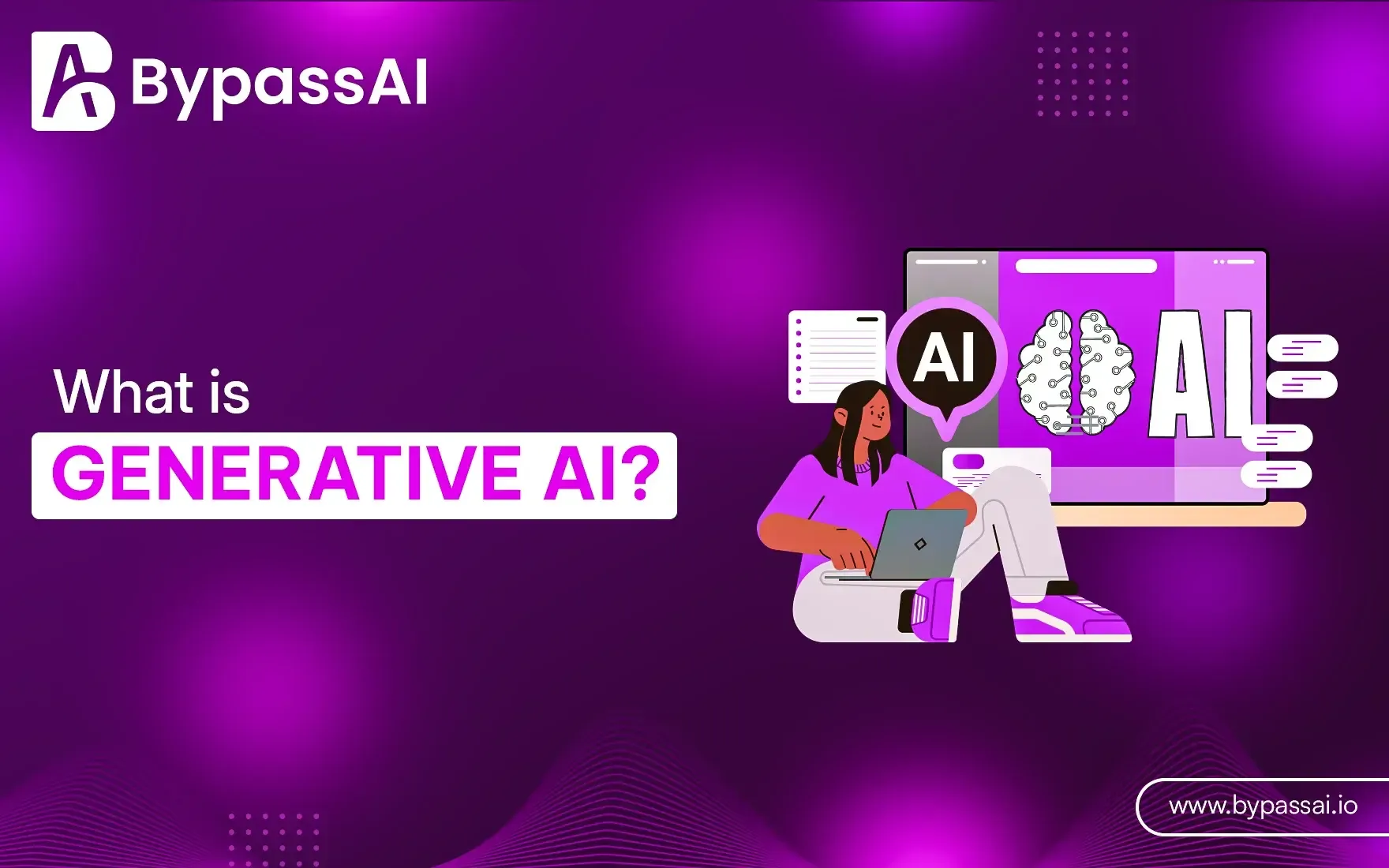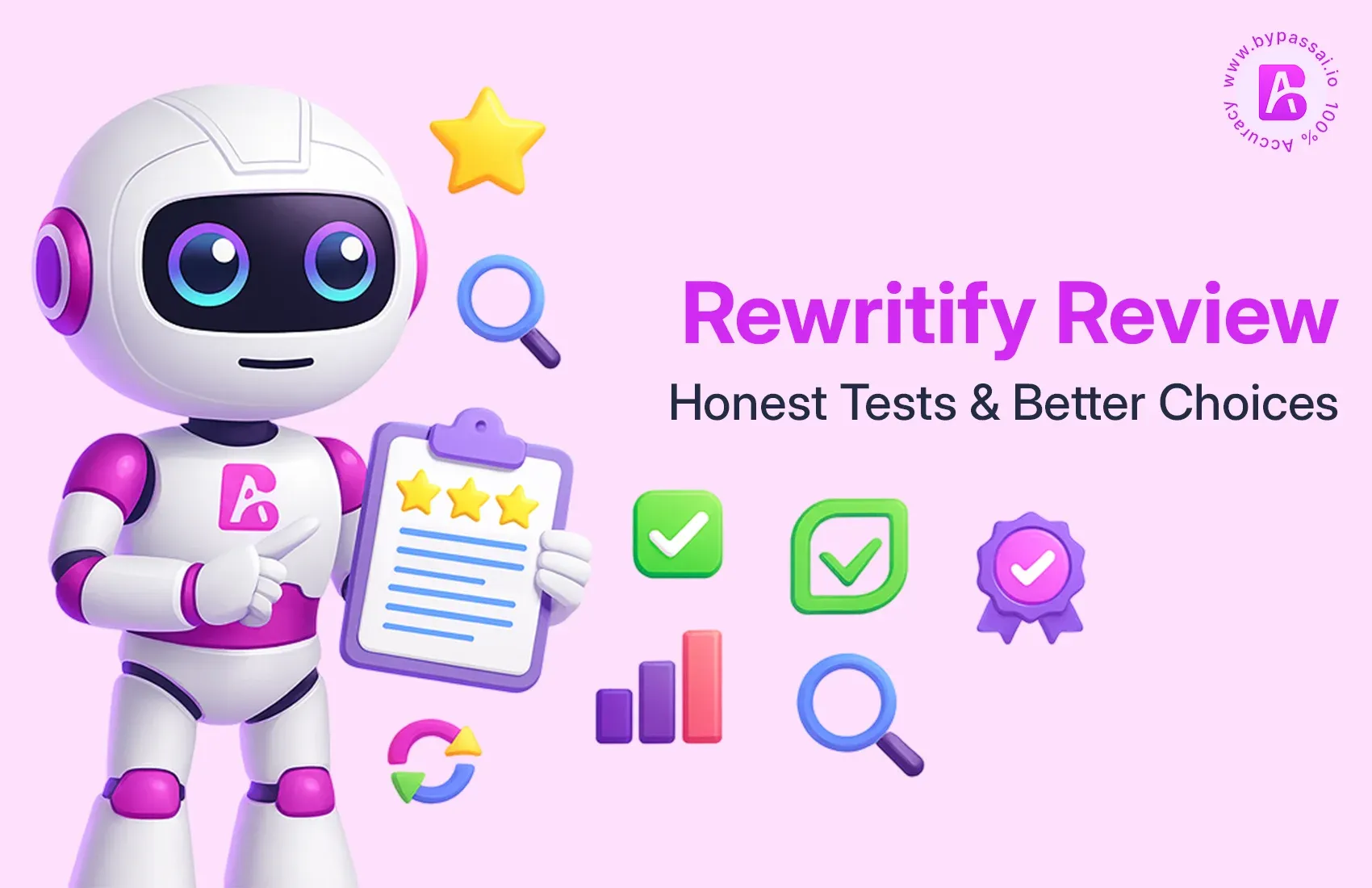Sign In
Welcome to Bypass AI! Sign in to continue your exploration of our platform with all its exciting features.
Forgot Password?
Don’t have an account ? Sign up
Sign Up
Embrace the Future with Bypass AI! Sign up now and let's rewrite the possibilities together.
You have an account ? Sign In
Enter OTP
We’ll send you an OTP on your registered email address
Back to Login
Forgot Password
We'll Send You An Email To Reset Your Password.
Back to Login
Enter OTP
We'll send you an email to reset your password.
Back to Login
Confirm Password
Please enter your new password.
TABLE OF CONTENTS
Quick Summary
What Is Generative AI?
Generative AI History
Deep Generative Models on the Rise
How Does Generative AI Work?
Key Features of Generative AI
Real-World Use Cases of Generative AI
Top GenAI Tools
Types of Generative AI Models
Advantages of Generative AI
Disadvantages of Generative AI
Examples of Generative AI
What is the Future of Generative AI Technology?
Generative AI vs. Traditional AI
OpenAI vs. Generative AI: What’s the Difference?
Conclusion
FAQs
You too must have seen many new image editing trends on the internet these days, in which people edit their photos using different styles, and this trend will increase as new image models are coming, you too must be curious that how it generates such realistic and perfect images, actually Generative AI has a huge contribution in this, because Generative AI generates text, image or video formats realistically, seeing which most of the people will not be able to tell whether it is real or not.
In the last 3 years, I have explored many generative platforms like ChatGPT, Bard, DALL-E, and Gemini. From my experience, I can say that Generative AI is not a mixed concept, but it is a kind of transformative technology that can generate unique text, image or video content using its intelligence.
In today's article, we will learn in detail about Generative AI, what it is, how it works and in what cases it is used.
Quick Summary
Mostly, AI tools and platforms are integrating Generative AI because it has the capabilities to generate realistic content, making it easy to generate a lot of media and text content using Generative AI, and it takes many hours for humans to generate the same content, but Generative AI can prepare it in seconds.
Generative AI is basically a branch of artificial intelligence, which is used to generate new, original and unique content. In 2025, Generative AI supports text, images, music, and code, and you can also generate results in these formats.
Our Focus in this article:
- What is Generative AI?
- How does Generative AI work, and what are its uses?
- What is the history and future trends of Generative AI?
- What challenges do beginners face in this?
What Is Generative AI?
Let us understand in simple language what Generative AI is. Basically, Generative AI is a very important branch of artificial intelligence. Generative AI can use its intelligence to produce new content in the format of text, images, music, code, or even 3D models.
Mostly, the traditional tools generate new content using existing data or patterns; in this, the result mostly seemed copied or of low quality, but Generative AI tries to generate unique and realistic content by using learning data. Generative AI generates new content by using human creativity and Intelligence. Due to Generative AI, humans have become capable of generating high-quality content by giving basic prompts.
Generative AI History
To understand generative AI in detail, it is very important that we understand it in a little detail. Let us try to understand the previous Gen AI.
1. Early Beginnings
The journey of generative AI started with relatively simple statistical models such as Markov chains, which relied on probabilities to predict the next word or note in a sequence. While these early approaches laid the foundation for automated text or music generation, their capabilities were quite limited.
Soon after, Recurrent Neural Networks (RNNs) emerged, introducing the concept of using the memory of previous inputs to generate more contextually relevant sequences. Although RNNs were a significant improvement, they often struggled with long-term dependencies and frequently produced outputs that lacked coherence, making them unreliable for generating long, meaningful text or complex musical compositions.
2. GAN Revolution
A major breakthrough came with the development of Generative Adversarial Networks (GANs), which completely reshaped the landscape of generative AI. Introduced by Ian Goodfellow in 2014, GANs use two competing neural networks, the generator and the discriminator, that work in tandem to create and evaluate outputs.
This adversarial process resulted in the creation of images that were astonishingly realistic, from lifelike human faces to stunning works of digital art. GANs sparked a revolution in creative AI, fueling advancements in fields like deepfake technology, fashion design, medical imaging, and even the gaming industry.
3. Transformers Era
The next great leap came with the advent of Transformer architectures, which fundamentally changed how machines process sequences of data. Models such as BERT pioneered contextual understanding of text, enabling AI systems to grasp nuances and relationships in language better than ever before.
This innovation paved the way for powerful language generators like GPT-2 and GPT-3, which demonstrated the ability to produce human-like conversations, stories, and even technical documentation. The transformer architecture’s ability to handle long-range dependencies and parallelize training allowed natural language generation to evolve from simple pattern imitation to highly creative, context-aware content creation.
4. Today
In the current era, the capabilities of generative AI have expanded even further with the rise of diffusion models and advanced large language models (LLMs). Diffusion models have revolutionized image and video synthesis, making it possible to create hyper-realistic visuals and detailed animations with stunning precision.
Meanwhile, next-generation LLMs such as Gemini 2.5 and GPT-4 have reached a level where they can generate not only high-quality text but also intricate code, complex data analyses, and even multimedia content in real time. These advancements have blurred the line between human and machine creativity, making generative AI a powerful tool across industries from entertainment and education to software development and scientific research.
Deep Generative Models on the Rise
As the use of GPT increases, deep generative models such as VAEs (Variational Autoencoders), GANs, and transformers are becoming the core components of generative AI.
GANs: It actually uses two neural networks, in which the generator and discriminator are used to create realistic outputs. This concept is evolving more as APIs become smoother.
VAEs: They encode data into a latent space and decode to generate similar content. VAEs pay special attention to intent and perception. It is also a very important component of generative AI.
Transformers/LLMs: It uses attention mechanisms in its model for relationships in data, and then it enables highly coherent text generation. These models power everything from image synthesis to natural language processing and even drug discovery.
How Does Generative AI Work?
Generative AI is built on the idea of teaching machines to learn patterns, structures, and relationships hidden inside enormous datasets of human-created content, everything from text and images to music and code. By analysing these massive collections of data, the AI doesn’t just memorize examples; it understands the underlying logic and patterns. This understanding allows it to create completely new outputs that feel original yet follow the natural flow of human creativity.
Two Key Training Approaches
To develop this capability, generative AI models are typically trained using one, or a combination of the following approaches:
1. Supervised Learning
In this method, the model is trained on labelled datasets, meaning the input data is paired with the correct output. For example, if the goal is to teach the AI to generate music, the dataset might contain thousands of songs labelled with their corresponding genres or moods. Over time, the model learns to produce outputs that resemble human examples and can replicate specific styles or categories.
2. Unsupervised / Self-Supervised Learning
The unsupervised learning AI explores data without explicit labels, identifying hidden patterns and structures on its own. Large language models (LLMs) such as GPT-4 and Gemini 2.5 often rely heavily on this approach. Instead of being told what each sentence or paragraph means, they learn to predict the next word or phrase by analyzing billions of examples. This self-directed learning helps the AI capture complex relationships between words, enabling it to generate natural, context-aware text.
Once trained, the process of generation is surprisingly straightforward from a user’s perspective. When you provide a prompt, say, “Create a logo of a sunrise with pastel colours” the AI draws on everything it has learned to predict what a “sunrise logo” should look like. It then uses this prediction to create a completely unique image, not just a copy of something it has seen before.
Key Features of Generative AI
Through extensive personal testing across multiple platforms and tools, these features consistently define the GenAI experience:
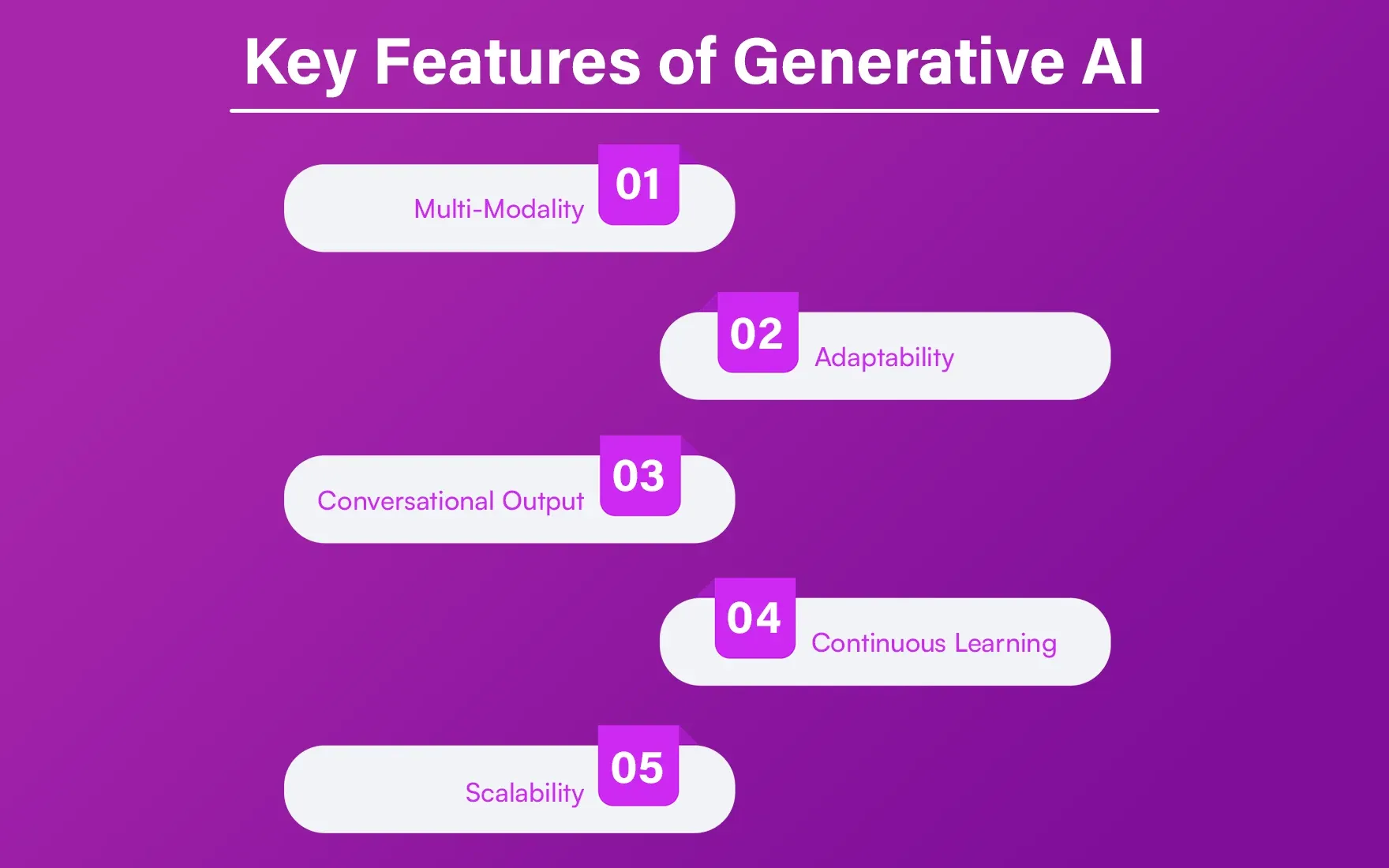
Multi-Modality: Modern generative models are not limited to text. They can create images, audio, video, and even 3D objects, making them highly versatile for creative and technical tasks.
Adaptability: With minimal additional training data, these models can be fine-tuned for niche tasks, such as generating legal documents, medical research summaries, or branded marketing content.
Conversational Output: Advanced LLMs deliver human-like, natural interactions, allowing users to chat, brainstorm, or even co-write content with the AI in real time.
Continuous Learning: While individual models are usually trained on a fixed dataset, many systems improve over time as they are exposed to more user feedback and updated data sources.
Scalability: Generative AI can produce thousands of high-quality outputs quickly and cost-effectively, making it ideal for industries that rely on rapid content generation.
Real-World Use Cases of Generative AI
Generative AI is already reshaping multiple industries and creating measurable value:
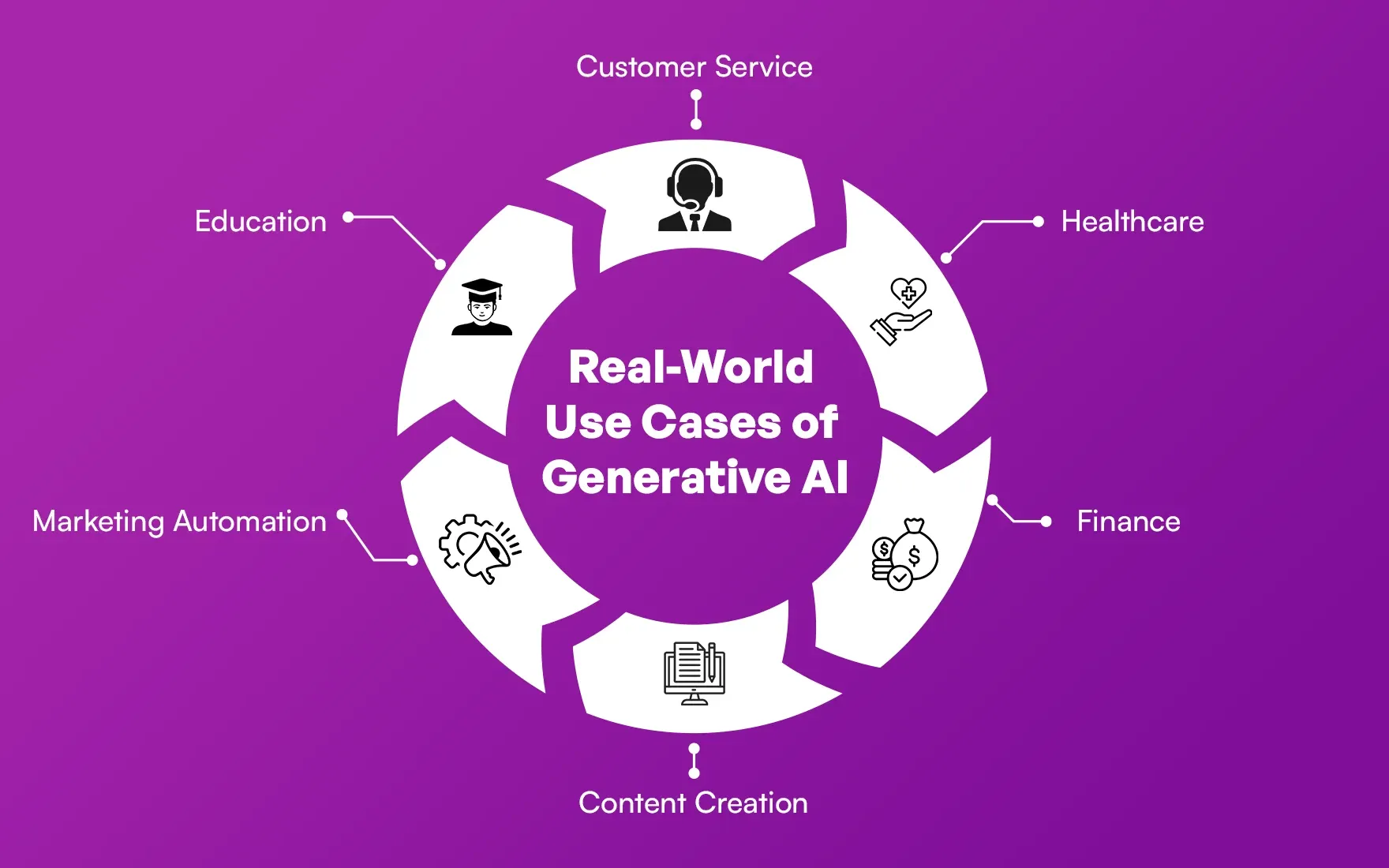
Customer Service: Intelligent chatbots provide 24/7 support, resolving customer queries instantly and freeing human agents for complex issues.
Healthcare: Researchers use generative AI to create synthetic patient data, which helps train diagnostic models while protecting real patient privacy.
Finance: AI models simulate market conditions, assist in fraud detection, and help predict trading patterns with remarkable accuracy.
Content Creation: Businesses and creators leverage AI to produce automated blogs, product descriptions, social media visuals, and even scripts for videos or podcasts.
Marketing Automation: Marketers use generative AI to craft personalized email campaigns, dynamic ad copy, and targeted promotional materials, improving engagement rates.
Education: AI-driven virtual tutors create interactive lessons, quizzes, and adaptive learning materials, making education more accessible and personalized.
Top GenAI Tools
We have learned a lot about Generative AI, now let's know about the top GenAI tools so that you can choose the best tool according to your needs, and you do not have any confusion.
1. ChatGPT
Developed by OpenAI, ChatGPT is built on the Generative Pre-trained Transformer (GPT) architecture, which enables it to produce human-like, contextually aware conversational text. It has quickly become one of the most versatile and accessible AI tools available today. From my personal experience, ChatGPT is incredibly useful for a wide range of tasks, drafting long-form articles, summarizing complex topics, generating code snippets, or even brainstorming creative ideas for projects and content.

Its ability to understand nuanced prompts and carry on coherent, natural-sounding conversations makes it feel like a reliable virtual assistant.
Whether you’re a developer seeking help with programming, a writer needing inspiration, or a business professional preparing reports, ChatGPT provides quick, accurate, and well-structured responses.
2. Bard (Now Gemini)
Originally launched as Bard, Google’s conversational AI is now part of the Gemini family, representing the next generation of Google’s large language models. What sets Bard, now Gemini, apart is its strength in search-enhanced answers and real-time updates, drawing directly from the web to provide fresh, fact-based information.
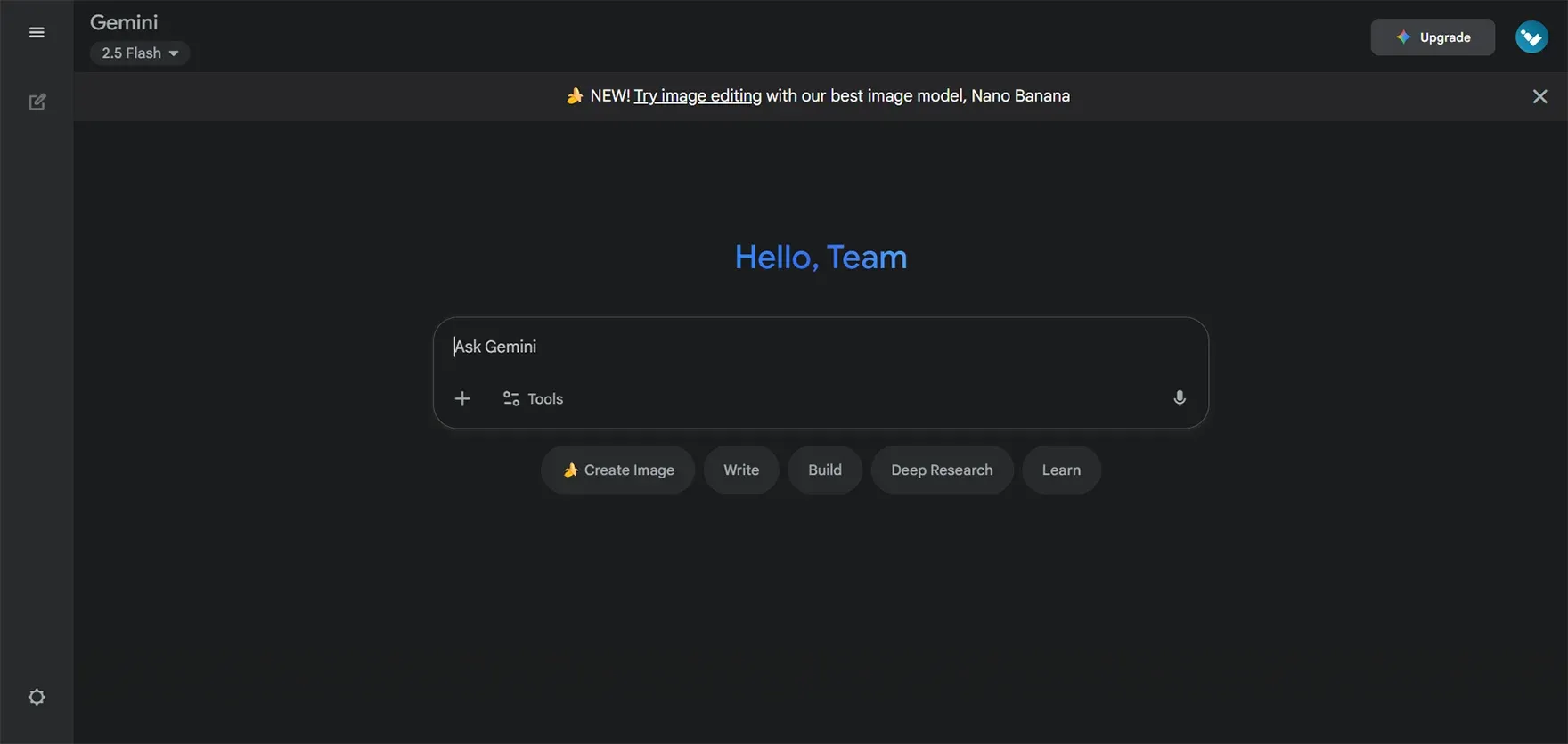
I often turn to Bard/Gemini when I need to cross-check facts, gather the latest news or research, or get creative writing assistance. Its integration with Google’s ecosystem makes it particularly powerful for people who rely on real-time data or want to merge search capabilities with conversational AI. For anyone who needs up-to-date information or wants to combine research and creativity, Gemini is a dependable companion.
3. DALL·E
Another remarkable innovation from OpenAI, DALL·E specializes in image generation from text prompts. By simply describing what you want, whether it’s “a futuristic cityscape at sunset” or “a minimalist marketing banner with pastel tones”, DALL·E can produce professional-quality visuals in seconds.
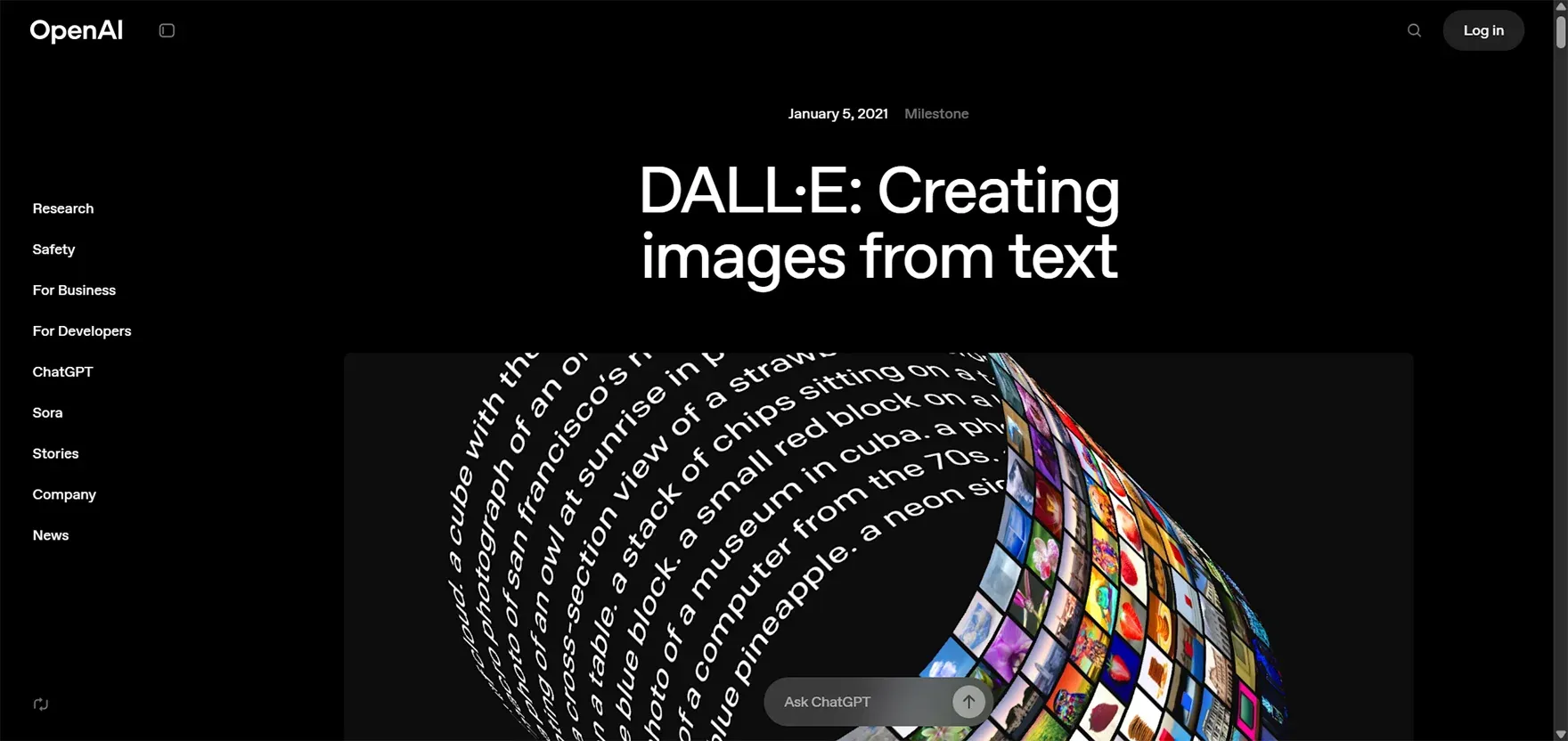
It has become an essential tool for designers, marketers, and content creators, allowing them to quickly generate unique concept art, illustrations, product mockups, or even personalized social media graphics without needing advanced design skills. Its ability to blend creativity and precision makes DALL·E a go-to solution for visual storytelling and fast, on-demand creative work.
4. Gemini
Google’s Gemini 2.5, available through Vertex AI, is currently one of the most advanced multimodal AI models in the industry. Unlike traditional language models that focus mainly on text, Gemini 2.5 can generate and interpret text, images, audio, and even video, making it a true all-in-one creative engine. Whether you want to create detailed written content, generate complex data visualizations, analyse audio files, or even produce short videos, Gemini 2.5 brings all these capabilities under a single platform.
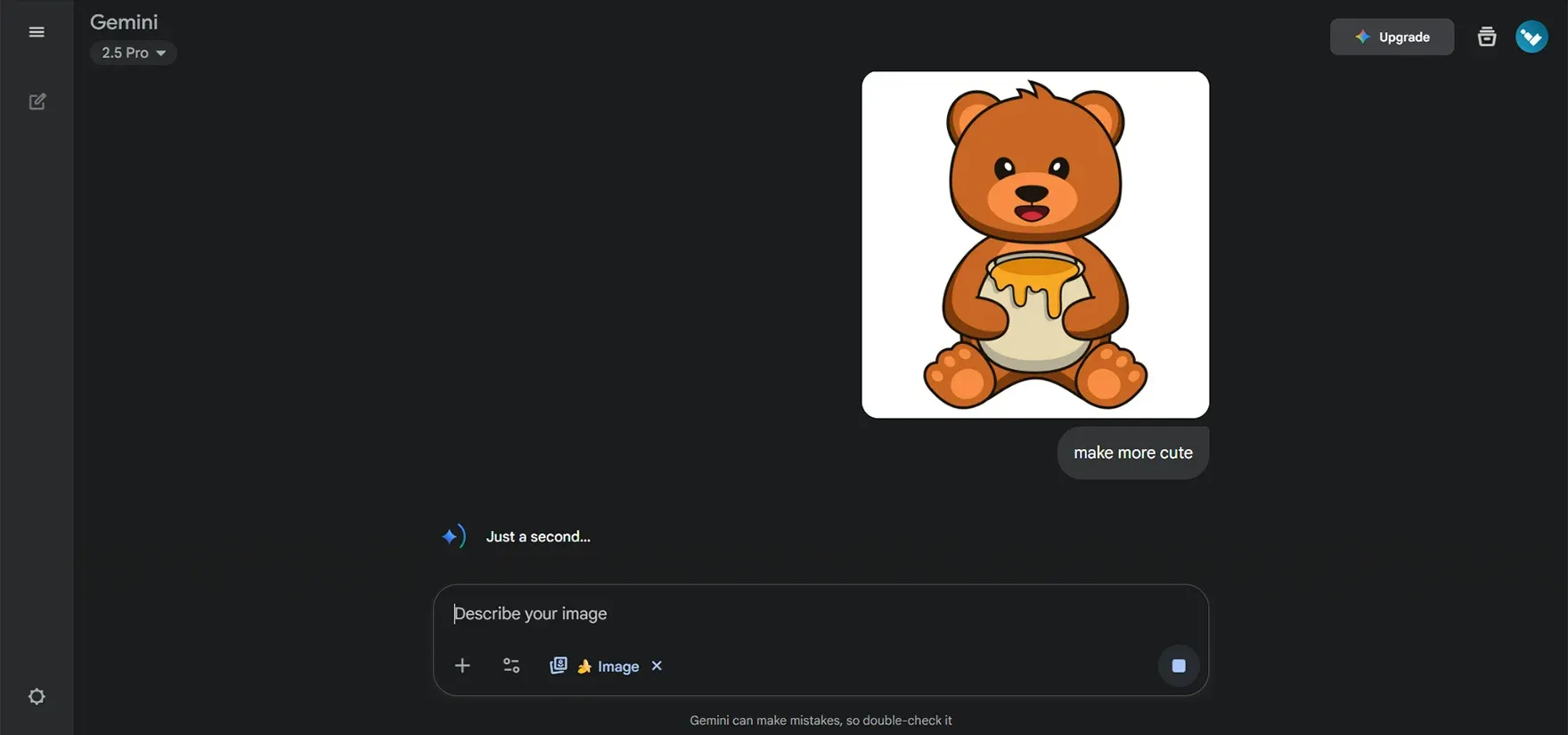
For businesses and creators who need a versatile AI solution that seamlessly handles multiple forms of media, Gemini stands out as a powerful next-generation tool.
Types of Generative AI Models
To make Generative AI capable of dedicated work, different models of Generative AI have been created. Let us know about the types of Generative AI Models.
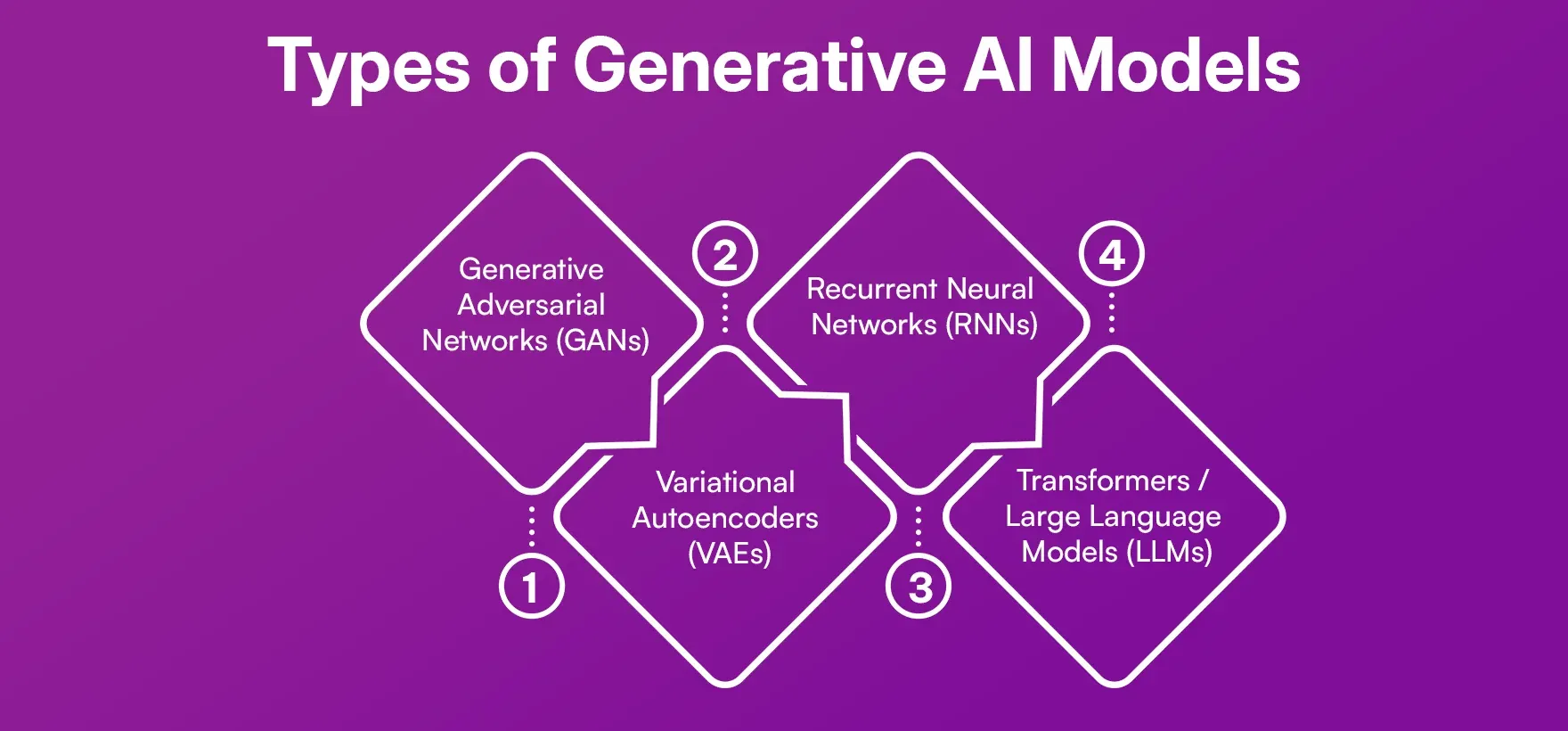
1. Generative Adversarial Networks (GANs)
Best for: It's good for creating photorealistic images, deepfakes, and high-quality visual content.
How they work
Introduced by Ian Goodfellow in 2014, GANs consist of two competing neural networks, a generator and a discriminator. The generator creates images (or other outputs), while the discriminator evaluates them to check whether they look real or fake. This adversarial “game” continues until the generator learns to create outputs so realistic that the discriminator can no longer tell them apart from real data.
Real-world examples
- It generates lifelike human faces (used in entertainment, fashion, and gaming).
- It's helpful for creating artwork and digital designs for marketing campaigns.
- Producing deepfakes (controversial but also used for movie special effects).
- Enhancing medical imaging for research and diagnostics.
GANs revolutionized the field of computer vision by making hyper-realistic image generation possible in seconds.
2. Variational Autoencoders (VAEs)
Best for: It's mostly used for producing variations of data, such as music, text, or complex scientific simulations.
How they work
VAEs encode input data into a compressed “latent space,” then decode it back into an output while adding controlled randomness. This ability to generate slightly different versions of the same type of data makes VAEs ideal for creative tasks where diversity is valuable.
Real-world examples
- It composes new music tracks inspired by existing melodies.
- Generating variations of product designs for rapid prototyping.
- Creating synthetic text or handwriting samples for training AI systems.
- Modelling molecular structures for drug discovery.
VAEs excel at tasks where you need creative variation rather than exact replication.
3. Recurrent Neural Networks (RNNs)
Best for: This is best for handling sequential data, including time-series data, speech, or natural language.
How they work
RNNs process information one step at a time, remembering previous steps through an internal “memory” mechanism. This makes them well-suited for tasks where the order of information matters, such as predicting the next word in a sentence or analyzing stock market trends.
Real-world examples
It's mostly used for speech recognition and voice synthesis in virtual assistants.
Predicting financial time-series patterns such as stock movements.
Early forms of text generation and machine translation.
Music composition by modelling note sequences.
While RNNs were groundbreaking, they sometimes struggled with long-term dependencies, which paved the way for more advanced models like transformers.
4. Transformers / Large Language Models (LLMs)
Best for: Powering text generation, chatbots, translation tasks, and multimodal AI applications.
How they work
Transformers introduced the concept of self-attention, allowing the model to analyze all words in a sentence at once, rather than sequentially. This architecture makes it easier to capture long-range relationships in text. Large Language Models (LLMs) like GPT-4, Gemini 2.5, and Claude are built on transformers and trained on massive datasets, enabling them to produce text that is fluent, context-aware, and human-like.
Real-world examples
- Chatbots such as ChatGPT and Google Gemini are for natural, interactive conversations.
- Machine translation tools like Google Translate.
- Automated content creation, from blogs to marketing copy.
- Code generation and software development assistance.
Transformers have become the foundation of modern generative AI, powering everything from conversational assistants to complex multimodal systems that can handle text, images, and even video.
Advantages of Generative AI
Generative AI has become a very important part of artificial intelligence today, and it also has many advantages, due to which businesses prefer it. Let's understand in detail.
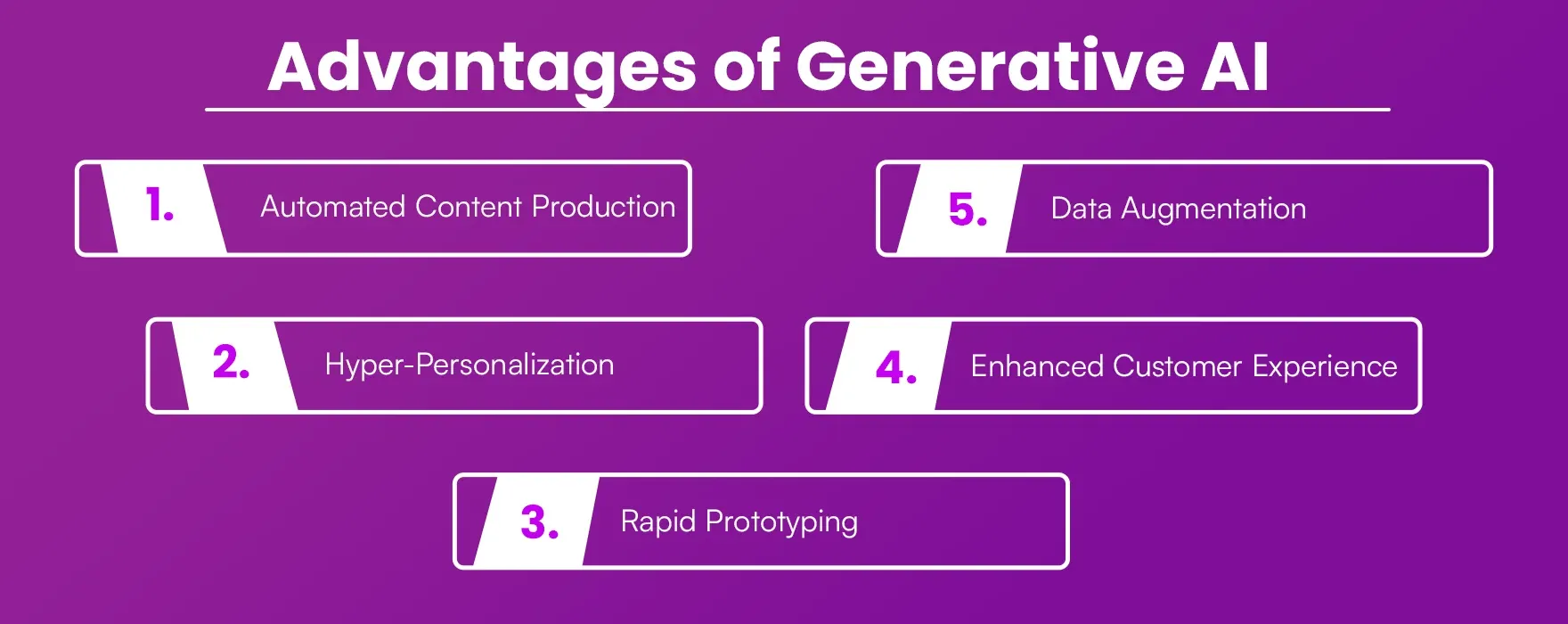
1. Automated Content Production
Generative AI drastically reduces time and cost for industries like marketing, journalism, and design. Instead of spending days writing articles or designing visuals, AI tools can generate high-quality blogs, ad copy, videos, or graphics in minutes.
For example, a marketing agency can use AI to create hundreds of personalized product descriptions in a fraction of the time it would take a human team.
2. Hyper-Personalization
By analyzing user behaviour and preferences, generative AI can tailor content and recommendations to each individual user. Think of how streaming services like Netflix or music apps like Spotify suggest shows or playlists uniquely suited to you.
This level of personalized engagement increases customer satisfaction and retention, making AI a powerful tool for businesses.
3. Rapid Prototyping
For product designers and developers, generative AI accelerates the design and prototyping process. It can instantly create UI/UX mockups, 3D product models, or concept art, allowing teams to visualize and iterate on ideas much faster.
Startups and creative agencies benefit from this by cutting down on time-to-market and reducing development costs.
4. Enhanced Customer Experience
AI-powered chatbots and virtual assistants deliver real-time, context-aware interactions, making customer support more efficient and engaging.
For example, AI can handle complex queries, provide instant troubleshooting, and even understand emotional cues in customer messages, creating a more human-like and satisfying customer experience.
5. Data Augmentation
Generative AI can produce synthetic datasets, which are invaluable for training other AI systems. In fields like healthcare, where privacy is critical, AI-generated medical records can help researchers develop new models without exposing real patient data.
This not only protects privacy but also ensures that AI models are trained on diverse and balanced datasets, improving their accuracy.
Disadvantages of Generative AI
Generative AI is still evolving, which means it also has many flaws and errors. Let's understand the major disadvantages.
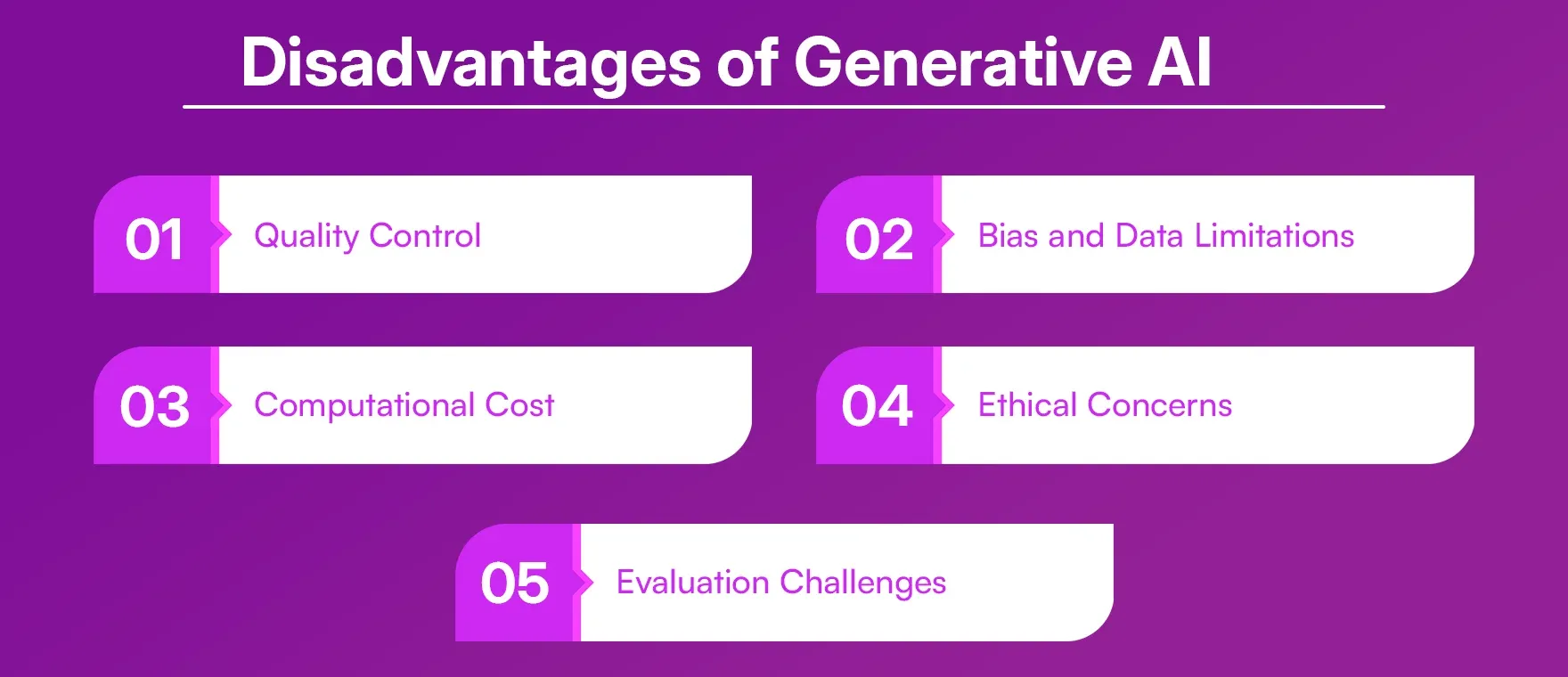
1. Quality Control
AI models, while powerful, can sometimes produce inaccurate, misleading, or incoherent outputs. For instance, a chatbot might generate factually incorrect information or a design tool might create visuals that don’t align with brand guidelines. Human oversight remains critical.
2. Bias and Data Limitations
Because generative AI learns from existing datasets, it may inherit biases present in that data. This can lead to outputs that unintentionally reinforce stereotypes or exclude certain perspectives, creating ethical and social concerns.
3. Computational Cost
Training large-scale generative models requires high-end GPUs or TPUs, which demand substantial financial and energy resources. This makes advanced AI research and deployment expensive, particularly for small organizations or startups.
4. Ethical Concerns
Generative AI has raised serious ethical challenges, such as the creation of deepfakes, the spread of misinformation, and potential copyright violations. These issues have led to calls for stronger AI governance and stricter regulations.
5. Evaluation Challenges
Unlike traditional AI models that can be measured using accuracy or precision, evaluating the “creativity” or quality of AI-generated content is subjective.
Determining whether an output is truly original or valuable can be complex and often requires human judgment.
Examples of Generative AI
Generative AI is already being used in diverse real-world scenarios. Let's know some major examples
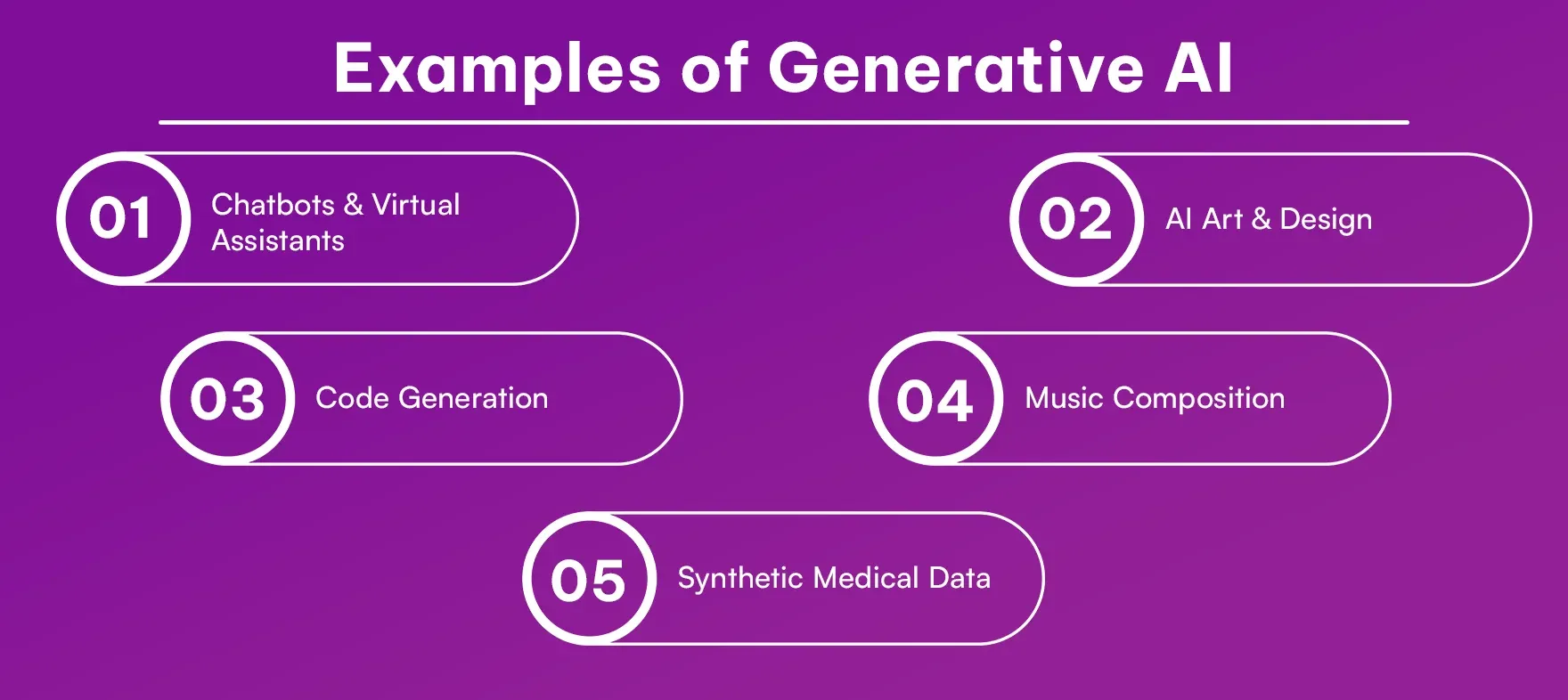
Chatbots & Virtual Assistants: Tools like ChatGPT and Google Bard/Gemini handle customer queries, provide information, and engage in natural conversations.
AI Art & Design: Platforms such as DALL-E, Midjourney, and Stable Diffusion create stunning artwork, digital designs, and concept illustrations from text prompts.
Code Generation: Services like GitHub Copilot assist developers by writing code snippets, speeding up software development.
Music Composition: AI tools like AIVA compose original music for films, games, and creative projects.
Synthetic Medical Data: AI generates privacy-friendly datasets that help researchers train models without exposing real patient information.
These examples show how generative AI is not confined to one industry; its influence spans from entertainment and education to healthcare and enterprise solutions.
What is the Future of Generative AI Technology?
The future of generative AI is incredibly promising, with emerging trends pointing toward even greater innovation and adoption: Multimodal AI
Future models will seamlessly combine text, images, audio, and video in a single platform. Imagine an AI that can write a script, generate visuals, and create background music, all in one workflow.
1. Federated & Decentralized AI
Privacy concerns will drive the growth of federated learning, where AI models are trained across multiple devices without centralized data storage, ensuring stronger data protection and user privacy.
2. Ethical & Responsible AI
Governments and organizations are already working on regulations and ethical frameworks to prevent misuse, protect intellectual property, and address bias in AI-generated content.
3. Human-AI Collaboration
Instead of replacing humans, future AI will act as a creative partner, helping writers, artists, and developers co-create innovative projects. AI will increasingly become a co-pilot in professional and creative tasks.
We can expect faster, more accessible models, deeper integration into everyday applications, and powerful tools that will transform sectors ranging from healthcare diagnostics to immersive gaming experiences.
Generative AI vs. Traditional AI
Generative AI and traditional AI are both in the same category of generative, but their working and purposes are quite different. Let us understand this by breaking it down through a table.
| Aspect | Traditional Ai | Generative Ai |
|---|---|---|
| Purpose | It focuses on classification and prediction, such as detecting spam emails and recognising images | It focuses on creation, generating new content such as images, Essays or music |
| Output | It provides fixed answers based on existing rules or data. | It provides novel outputs that don't previously exist |
| Approach | It is usually deterministic, and it relies on predefined algorithms | It's probabilistic or pattern, and it predicts what new content should look or sound like |
OpenAI vs. Generative AI: What’s the Difference?
There are many people and professionals who think that OpenAI and Generative AI are the same, but in reality, both are quite different. Let's try to understand this in a little detail.
Basically OpenAI is a research organization and technology company. It is the creator of well-known tools and models such as ChatGPT, GPT-4, and DALL-E.
Generative AI, on the other hand, is a broader field of technology focused on creating new content, text, images, music, video, and more, through machine learning. You can think of Generative AI as a high-end technology.
If we understand both in simple terms, basically OpenAI builds generative AI tools and generative AI as a concept extends far beyond OpenAI, including innovations from Google's Gemini, Anthropic's Cloud, and countless open-source projects worldwide. Generative AI is a very complex part of Artificial Intelligence. I hope you have understood the basic difference between the two.
Conclusion
Generative AI is not a fictional concept but is becoming a highly profitable technology for 36% in IT and 12% in the manufacturing sectors in 2025. I have worked extensively on Generative AI platforms such as Gemini and DALL-E and can say from my experience that it is the best tool for the business sector, as it can help with everything from your business operations to new product creation.
Generative AI is still evolving, so it is important that it is managed by skilled teams to maintain overall creativity and accuracy. Apart from this, you can use BypassAi for copywriting in your business if you do not know how to use Generative AI tools.
FAQs
1: Is Generative AI the same as machine learning?
These two are not completely the same because generative AI is a subset of machine learning, whose core focus is on creating content based on new data. And the core focus of machine learning includes all the algorithms that are used to learn from data and make predictions or classifications.
2: Can I train my own generative AI model?
Yes, you can train generative AI models using frameworks such as TensorFlow or PyTorch, but for this, you must have powerful hardware and access to a large, diverse dataset.
3: What are some free generative AI tools?
There are many free generative AI tools available in the market like ChatGPT, DALL-E and Google Gemini. All of these provide limited free trials that you can use, and their overall prices also fluctuate and vary from country to country.
4: Is generative AI safe to use for business?
Yes, generative AI is safe for businesses if used responsibly. Always monitor it to maintain accuracy and make sure your tool follows privacy laws.
5: Will generative AI replace human creativity?
Generative AI will only replace repetitive tasks, but it will not replace creative or complex thinking tasks.

